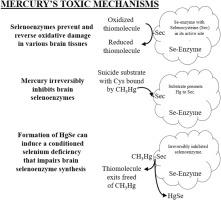当前位置:
X-MOL 学术
›
Neurotoxicology
›
论文详情
Our official English website, www.x-mol.net, welcomes your
feedback! (Note: you will need to create a separate account there.)
Maternal seafood consumption is associated with improved selenium status: Implications for child health
NeuroToxicology ( IF 3.4 ) Pub Date : 2024-01-23 , DOI: 10.1016/j.neuro.2024.01.003 Nicholas V C Ralston 1 , Laura J Raymond 2 , Christy L Gilman 3 , Reni Soon 4 , Lucia A Seale 5 , Marla J Berry 5
NeuroToxicology ( IF 3.4 ) Pub Date : 2024-01-23 , DOI: 10.1016/j.neuro.2024.01.003 Nicholas V C Ralston 1 , Laura J Raymond 2 , Christy L Gilman 3 , Reni Soon 4 , Lucia A Seale 5 , Marla J Berry 5
Affiliation

|
Selenium (Se) is required for synthesis of selenocysteine (Sec), an amino acid expressed in the active sites of Se-dependent enzymes (selenoenzymes), including forms with essential functions in fetal development, brain activities, thyroid hormone metabolism, calcium regulation, and to prevent or reverse oxidative damage. Homeostatic mechanisms normally ensure the brain is preferentially supplied with Se to maintain selenoenzymes, but high methylmercury (CHHg) exposures irreversibly inhibit their activities and impair Sec synthesis. Due to Hg’s high affinity for sulfur, CHHg initially binds with the cysteine (Cys) moieties of thiomolecules which are selenoenzyme substrates. These CHHg-Cys adducts enter selenoenzyme active sites and transfer CHHg to Sec, thus irreversibly inhibiting their activities. High CHHg exposures are uniquely able to induce a conditioned Se-deficiency that impairs synthesis of brain selenoenzymes. Since the fetal brain lacks Se reserves, it is far more vulnerable to CHHg exposures than adult brains. This prompted concerns that maternal exposures to CHHg present in seafood might impair child neurodevelopment. However, typical varieties of ocean fish contain far more Se than CHHg. Therefore, eating them should augment Se-status and thus prevent Hg-dependent loss of fetal selenoenzyme activities. To assess this hypothesis, umbilical cord blood and placental tissue samples were collected following delivery of a cohort of 100 babies born on Oahu, Hawaii. Dietary food frequency surveys of the mother’s last month of pregnancy identified groups with no (0 g/wk), low (0–12 g/wk), or high (12 + g/wk) levels of ocean fish consumption. Maternal seafood consumption increased Hg contents in fetal tissues and resulted in ∼34% of cord blood samples exceeding the EPA Hg reference level of 5.8 ppb (0.029 µM). However, Se concentrations in these tissues were orders of magnitude higher and ocean fish consumption caused cord blood Se to increase ∼9.4 times faster than Hg. Therefore, this study supports the hypothesis that maternal consumption of typical varieties of ocean fish provides substantial amounts of Se that protect against Hg-dependent losses in Se bioavailability. Recognizing the pivotal nature of the Hg:Se relationship provides a consilient perspective of seafood benefits vs. risks and clarifies the reasons for the contrasting findings of certain early studies.
中文翻译:

孕妇食用海鲜与改善硒状况有关:对儿童健康的影响
硒 (Se) 是合成硒代半胱氨酸 (Sec) 所必需的,硒代半胱氨酸是一种在硒依赖性酶(硒酶)活性位点表达的氨基酸,包括在胎儿发育、大脑活动、甲状腺激素代谢、钙调节、并防止或逆转氧化损伤。稳态机制通常确保大脑优先获得 Se 来维持硒酶,但高甲基汞 (CHHg) 暴露会不可逆地抑制其活动并损害 Sec 合成。由于 Hg 对硫的高亲和力,CHHg 最初与作为硒酶底物的硫分子的半胱氨酸 (Cys) 部分结合。这些CHHg-Cys加合物进入硒酶活性位点并将CHHg转移至Sec,从而不可逆地抑制其活性。高 CHHg 暴露特别能够诱发条件性缺硒,从而损害脑硒酶的合成。由于胎儿大脑缺乏硒储备,因此它比成人大脑更容易受到 CHHg 暴露的影响。这引发了人们的担忧,即母亲接触海鲜中的 CHHg 可能会损害儿童的神经发育。然而,典型的海洋鱼类品种的硒含量远高于 CHHg。因此,食用它们可以增加硒的状态,从而防止胎儿硒酶活性的汞依赖性损失。为了评估这一假设,我们在夏威夷欧胡岛出生的 100 名婴儿出生后收集了脐带血和胎盘组织样本。对母亲怀孕最后一个月的膳食食物频率调查确定了没有(0 克/周)、低(0-12 克/周)或高(12 + 克/周)海鱼消费水平的群体。 母亲食用海鲜会增加胎儿组织中的汞含量,导致约 34% 的脐带血样本超过 EPA 汞参考水平 5.8 ppb (0.029 µM)。然而,这些组织中的硒浓度要高出几个数量级,并且食用海鱼导致脐带血中硒的增加速度比汞快约 9.4 倍。因此,这项研究支持这样的假设:母亲食用典型的海洋鱼类品种可以提供大量的硒,从而防止汞依赖性的硒生物利用度损失。认识到 Hg:Se 关系的关键性质,可以为海鲜的益处与风险提供一致的视角,并澄清某些早期研究结果出现对比的原因。
更新日期:2024-01-23
中文翻译:

孕妇食用海鲜与改善硒状况有关:对儿童健康的影响
硒 (Se) 是合成硒代半胱氨酸 (Sec) 所必需的,硒代半胱氨酸是一种在硒依赖性酶(硒酶)活性位点表达的氨基酸,包括在胎儿发育、大脑活动、甲状腺激素代谢、钙调节、并防止或逆转氧化损伤。稳态机制通常确保大脑优先获得 Se 来维持硒酶,但高甲基汞 (CHHg) 暴露会不可逆地抑制其活动并损害 Sec 合成。由于 Hg 对硫的高亲和力,CHHg 最初与作为硒酶底物的硫分子的半胱氨酸 (Cys) 部分结合。这些CHHg-Cys加合物进入硒酶活性位点并将CHHg转移至Sec,从而不可逆地抑制其活性。高 CHHg 暴露特别能够诱发条件性缺硒,从而损害脑硒酶的合成。由于胎儿大脑缺乏硒储备,因此它比成人大脑更容易受到 CHHg 暴露的影响。这引发了人们的担忧,即母亲接触海鲜中的 CHHg 可能会损害儿童的神经发育。然而,典型的海洋鱼类品种的硒含量远高于 CHHg。因此,食用它们可以增加硒的状态,从而防止胎儿硒酶活性的汞依赖性损失。为了评估这一假设,我们在夏威夷欧胡岛出生的 100 名婴儿出生后收集了脐带血和胎盘组织样本。对母亲怀孕最后一个月的膳食食物频率调查确定了没有(0 克/周)、低(0-12 克/周)或高(12 + 克/周)海鱼消费水平的群体。 母亲食用海鲜会增加胎儿组织中的汞含量,导致约 34% 的脐带血样本超过 EPA 汞参考水平 5.8 ppb (0.029 µM)。然而,这些组织中的硒浓度要高出几个数量级,并且食用海鱼导致脐带血中硒的增加速度比汞快约 9.4 倍。因此,这项研究支持这样的假设:母亲食用典型的海洋鱼类品种可以提供大量的硒,从而防止汞依赖性的硒生物利用度损失。认识到 Hg:Se 关系的关键性质,可以为海鲜的益处与风险提供一致的视角,并澄清某些早期研究结果出现对比的原因。













































 京公网安备 11010802027423号
京公网安备 11010802027423号